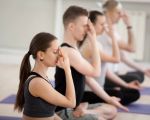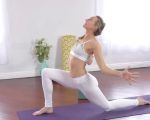- 1 - Understanding-Restorative-Yoga
- 2 - Benefits-of-Restorative-Yoga-for-Relaxation
- 3 - Best-Restorative-Yoga-Poses-for-Relaxation
- 4 - How-to-Practice-Restorative-Yoga-Effectively
- 5 - Real-Life-Experience-and-Stories
- 6 - Incorporating-Restorative-Yoga-into-Daily-Life
- 7 - Explore-More-with-Free-Yoga-Links
1. Understanding Restorative Yoga
Restorative yoga is a gentle practice focusing on relaxation and healing through passive poses supported by props like blankets and bolsters. Unlike more vigorous yoga styles, restorative yoga encourages holding poses for several minutes to release tension deeply and calm the nervous system.
This practice is ideal for those seeking relief from stress, anxiety, or physical fatigue. It promotes mindfulness and deep breathing, helping practitioners reconnect with their bodies and minds in a peaceful setting.
2. Benefits of Restorative Yoga for Relaxation
Practicing restorative yoga regularly offers profound benefits such as reduced stress hormones, improved sleep quality, and decreased muscle tension. It activates the parasympathetic nervous system, which governs rest and digestion, making it highly effective for relaxation.
People who suffer from chronic pain or high-stress jobs often report enhanced emotional wellbeing and physical comfort after engaging in restorative yoga. Its slow pace and emphasis on stillness make it accessible for all ages and fitness levels.
3. Best Restorative Yoga Poses for Relaxation
Several restorative poses stand out for their calming effects:
Supported Child’s Pose (Balasana)
This pose gently stretches the back and hips while creating a nurturing sense of safety. Using a bolster under the torso enhances comfort.
Reclining Bound Angle Pose (Supta Baddha Konasana)
Opening the hips and chest, this pose helps release tension and improve breathing when supported by cushions.
Legs-Up-The-Wall Pose (Viparita Karani)
By elevating the legs, circulation improves and the nervous system calms, reducing anxiety and fatigue.
Savasana with Props
The ultimate relaxation pose, supported Savasana allows complete surrender and deep rest.
Each pose can be held for 5 to 15 minutes, encouraging mindful breathing and stillness.
4. How to Practice Restorative Yoga Effectively
To gain maximum benefits, create a quiet, comfortable space with all necessary props. Focus on slow, deep breaths and let go of any tension or expectations. Listening to guided sessions or attending classes can provide structure and support, especially for beginners.
Practicing regularly, even just 10-15 minutes daily, can lead to noticeable improvements in relaxation and stress management.
5. Real-Life Experience and Stories
Sarah, a busy professional, credits restorative yoga for helping her manage chronic anxiety. Through daily supported poses and deep breathing, she experienced improved sleep and calmness, allowing her to approach daily challenges with greater resilience.
Another practitioner, James, used restorative yoga to recover from a sports injury. The gentle stretches and mindful rest accelerated healing and reduced pain without strain.
6. Incorporating Restorative Yoga into Daily Life
Integrating restorative yoga into your routine can be simple. Consider starting or ending your day with a few calming poses. Use restorative yoga as a mindful break during stressful periods or before sleep to promote restfulness.
Combining restorative yoga with other wellness habits like meditation and balanced nutrition creates a holistic approach to relaxation and health.
7. Explore More with Free Yoga Links
For those interested in deepening their practice or discovering new restorative yoga sequences, Free Yoga Links offers a curated selection of classes, tutorials, and resources. Whether beginner or experienced, you can find guided content tailored to your relaxation and wellness goals.
Visit Free Yoga Links to explore the best restorative yoga poses for relaxation and elevate your mind-body connection today.








